Editorial
Ramos Was Right In Serena’s Controversy! Osaka, What A Champion
Serena Williams lost her mind like in her previous matches with Clijsters and Stosur. Naomi Osaka is a truly deserving champion. We have 8 different winners in the last 8 Grand Slams for the first time in 80 years.
Published
6 years agoon
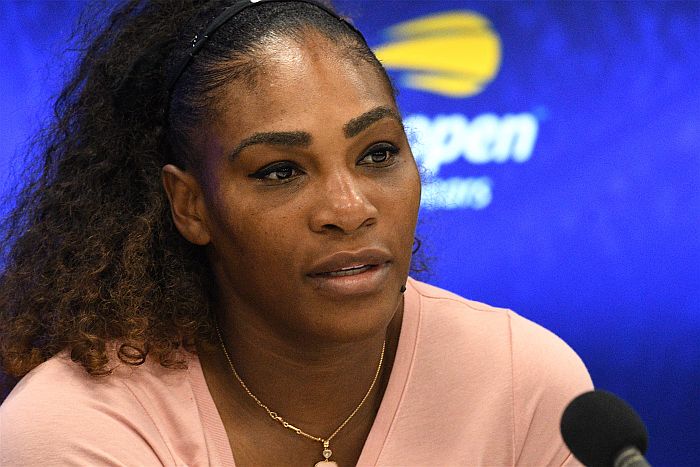
FLUSHING MEADOWS – What a mess Serena Williams made! Unreal! Williams’ outbursts during this year’s US Open final were extremely disappointing, especially coming from a player with her experience. Since becoming a mother last year, Williams has been very open and vocal about how she wants to be a role-model for her daughter Alexis Olympia. Serena’s behavior during the championship match and her words in her post-match press conference – during which she tried to act like a defender of women’s rights claiming that chair umpire Carlos Ramos would have never inflicted such warnings and penalties on a male player – certainly raised many eyebrows.
First and foremost, we must give credit where credit is due. Naomi Osaka deserved to win her first Grand Slam title against her idol, who is 16 years and 20 days older than she is. The Japanese rising star dominated the first set and kept her composure in the second when Serena was kicking and screaming after receiving three unquestionable warnings from the chair umpire. Serena first received a warning for coaching in the second game of the second set, as Ramos saw Serena’s coach Patrick Mouratoglou giving her signals from the stands. After the incident occurred, Mouratouglou couldn’t deny that he was trying to coach his player and publicly admitted it on Twitter. Was it necessary to do it? His statement certainly surprised Serena, who is probably livid with him. Will he now get fired?
Perhaps when Serena watches the video of the match, she will see how Mouratoglou was clearly trying to give her signals about moving forward in the court and attacking. Up until that point in the match, Williams was being outplayed from the baseline by her younger opponent. Serena said that she wasn’t even looking at her coach when the incident happened, but it is fair to say that Patrick did try to coach her. Perhaps Carlos Ramos was a little too strict in applying the rule to the letter, as both Williams’ sisters don’t even use on-court coaching in regular tour events where players are allowed to receive coaching visits during the match. It was probably a spontaneous initiative of Mouratoglou, who sometimes likes to be at the center of attention. Truth be told, he simply did what many coaches do in different ways and with different signals. He later claimed that all the coaches use signals to advise their players during matches and never get punished, including Toni Nadal.
As soon as Serena received the warning for coaching, she started with her first outburst towards the chair umpire: “I don’t cheat to win, I’d rather lose. I want you to know that”. She also asked him to remove the violation from her conduct, but Ramos was far from being intimidated by her words. It never happened that a chair umpire would give a warning to a player and then remove it. It is the chair umpire’s job to apply the rules and make sure that players respect them.
Whether Serena saw Patrick’s signal or not, the first incident of the match actually gave her an energy boost as she certainly started to move forward and play more aggressive. Osaka started showing a few nerves and Williams jumped to a 3-1 lead in the second set, while Arthur Ashe Stadium almost turned into a jungle with fans cheering and screaming for Serena.
The following game proved to be a disaster for Williams, as she double faulted twice and missed an easy backhand. Serena furiously smashed and broke her racquet, which triggered a second warning from the umpire: This time it was for racquet abuse. Since this was Williams’ second violation, it resulted into a penalty point. As Osaka was walking back to the service line, the chair umpire announced 15-0. Many spectators seemed to be confused about what happened. Serena started screaming at the umpire again: “You owe me an apology. I have never cheated in my life. I have a daughter and I stand for what’s right for her. I’ve never cheated, and you owe me an apology. You will never do another one of my matches”. Then she became even more aggressive towards him: “You are a liar and now you stole a point from me. You’re a thief”. At that point, Carlos Ramos issued a third warning towards Williams for word abuse, which resulted in a game penalty. Serena completely lost her mind as the crowd was loudly booing the chair umpire. The noise level was insane. Serena then called the referee Brian Earlie and the supervisor Donna Kelso, but she accomplished very little. Both the referee and supervisor could only stand by the umpire’s decisions.
Down 5-3, Serena managed to regroup and hold her serve, forcing Osaka to serve out the match. It was very remarkable how the young Japanese was able to keep her focus in the middle of such bizarre events, closing out the match with a great serve that Williams couldn’t get back.
“The spectators were making so much noise that I didn’t hear any of the conversations between Serena and the umpire. When the umpire announced the score at 5-3, I was a little confused, but I kept telling myself to stay focused. She is such a great champion and I thought that she could have come back into the match at any time”, Osaka said in her post-match press conference.
Williams accused Ramos of sexism while talking to the press after the match. Quite frankly, those accusations were ridiculous and inappropriate, and should have not been acknowledged by the press. Instead, a few idiots applauded Williams for her words.
Even if I want to give credit to Serena for regrouping and controlling her emotions during the trophy presentation, I don’t agree with her behavior. Perhaps the chair umpire was a little too strict when he gave her the first warning, but the second and third were absolutely on point. Serena lost her cool for the third time at the US Open after her previous incidents with chair umpires in the 2011 final against Stosur and the 2009 semifinal against Kim Clijsters. The best player on the court wasn’t Serena Williams, it was Naomi Osaka.
Osaka played with the class of a true champion. At 20 years of age, it is safe to say that she will win many more titles in the future. She has a great personality on and off the court and a remarkable sense of humor.
(Article translation provided by T&L Global – Translation & Language Solutions – www.t-lglobal.com )
You may like
-
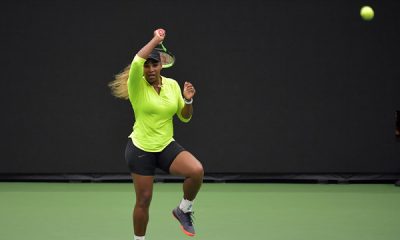

Serena Williams and Maria Sharapova’s US Open clash is about revival as much as about resurgence
-


If You Want An Example Of Sexism In Tennis, Focus On The US Open Doubles Champions
-


From Serena’s Meltdown To Kyrgios’ Pep Talk – 10 US Open Break Points
-


(VIDEO) DAY 14 At The US Open: Novak Djokovic Clinches Title And Matches His Idol Sampras
-


Only Novak Djokovic Could Have Dreamed Such Good Things Would Happen
-


Djokovic’s New Breath For Tennis Led Him To Two Major Titles in 2018
Editorial
Steve Flink: Andrey Rublev Deserves His Madrid Masters Triumph
Published
1 week agoon
06/05/2024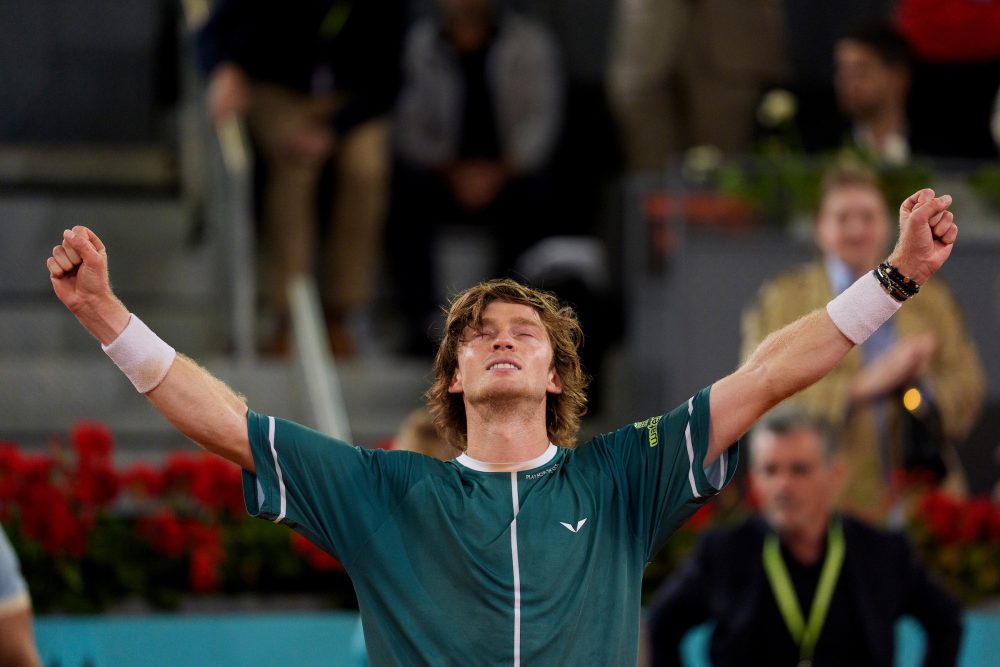
At the end of an injury plagued tournament on the red clay in Madrid, the fans witnessed a final round tussle that was entirely worthy of the occasion. Andrey Rublev and Felix Auger-Aliassime fought down to the wire in a high caliber contest. Rublev was searching for a second career Masters 1000 title as he sought to snap out of a slump, while Auger-Aliassime was making his first appearance in a title round meeting at this level. Both men wanted this tournament very badly, and the outcome of their duel was in doubt until the very end.
Ultimately, though, Rublev thoroughly deserved his triumph. It had been an arduous week for the 26-year-old, filled with sleepless nights, fraught with potential danger as he made his way through the draw with deep determination and a measure of pessimism. Rublev had been a pale imitation of himself in recent weeks, losing four matches in a row en route to Madrid and performing in recent weeks without his usual high intensity and emotional energy.
But an unwavering Rublev rediscovered the art of winning on the Spanish clay, and turned his season around resoundingly. At the outset of his final round appointment against Auger-Aliassime, Rublev was strangely subdued and noncommittal. The Canadian was swinging freely and controlling the climate of the match with his lethal forehand and devastatingly potent and accurate serve. Auger-Aliassime had been in a long slump of his own over the past year, and his presence in the final was not simply a turnaround in his form but additionally a result of some good fortune.
Consider his path to the final. He commenced his remarkable run with a come from behind victory over Japan’s Yoshihito Nishioka, a left-hander ranked No. 78 in the world. Auger-Aliassime won that encounter 4-6, 6-1, 6-4. Facing the Frenchman Adrian Mannarino in the second round, Auger-Aliassime advanced over a second straight southpaw adversary, prevailing 6-0, 6-4 against the 35-year-old stationed at No. 20 in the world.
Embed from Getty ImagesThose two wins were hard earned and well played. But the first instance of good luck for F.A.A was in his third round match against the rapidly rising young Czech Jakub Mensik, an 18-year-old 6’4” powerhouse ranked No. 74 in the world. Mensik had to retire in that confrontation with Auger-Aliassime ahead 6-1, 1-0. Now having reached the round of 16, Auger-Aliassime took on Casper Ruud, a man who has been to three finals at the majors in the past two years. Moreover, Ruud just took the title in Barcelona over Stefanos Tsitsipas after being runner-up to the Greek stylist in Monte Carlo.
Auger-Aliassime met that Ruud moment boldly. He took apart the 2022-2023 French Open finalist 6-4, 7-5, winning 78% of his first serve points and losing his serve only once to earn a quarterfinal assignment against top seeded Jannik Sinner. But the Italian was struggling inordinately with a hip injury and realized he was in no condition to compete at that level. He defaulted, sending Auger-Aliassime into the semifinals.
In the penultimate round, Auger-Aliassime was locked at 3-3 in the first set against Jiri Lehecka when the 22-year-old Czech, who had toppled Rafael Nadal brilliantly in the round of 16, had to retire with a bad back. Lehecka had won the opening set of his quarterfinal against Daniil Medvedev, but Medvedev was ailing and had to quit.
And so the Canadian arrived unconventionally in the final to take on Rublev under the oddest of circumstances, but hoping he could make the most of a big opportunity. He was outstanding in the early stages of the battle, while Rublev seemed to be feeling ill and was way out of sorts. Rublev double faulted on the first two points of the match and soon lost his serve at love. Auger-Aliassime held at 15 with an ace for 2-0 and even had a break point for 3-0 before Rublev held on tenuously.
Auger-Aliassime surged to 3-1 and then broke again. His game was flowing on all fronts as he kept Rublev at bay with explosive forehands, unstoppable first serves and a surprisingly stable backhand. The Canadian was close to sealing the set easily when he built a 4-1, 40-0 lead but inexplicably took his foot off the accelerator and Rublev broke in that sixth game.
Rublev now had a foothold in the final. At 3-5, he saved a set point, held on, and made Auger-Aliassime serve it out in the tenth game. The Canadian needed a service winner down the T to erase a break point against him and kept his composure to close out the set 6-4.
But the outlooks and dispositions of both players had changed sweepingly. Rublev was finding his range off his overpowering forehand which is right up there among the best in the sport. He also was serving magnificently. In his six service games over the course of the second set, Rublev won 25 of 32 points. He never faced a break point. With Auger-Aliassime serving at 5-6, Rublev pounced. He broke at 30 to close out the set with a typically impressive forehand return off a first serve landing deep down the middle and coaxing an error from his opponent.
Embed from Getty ImagesAll through the third set, Auger-Aliassime was fighting issues with his hamstrings in both legs, but his discipline and fighting spirit kept him in the match. Rublev, meanwhile, was holding even more comfortably than he had in the second set and stupendously finding the corners with his serve. He took 24 of 27 points in his service games with awesome power and precision, backing it up beautifully.
Auger-Aliassime, meanwhile, found himself confronting one precarious moment after another all across a harrowing third set, yet somehow he kept extricating himself by virtue of some clutch serving and daring play from the backcourt. Serving at 0-1, he fended off two break points with a dazzling forehand down the line winner and an ace. On he went to 1-1. In the fourth game he trailed 15-40 but poured in four first serves in a row including an ace and a service winner on the break points. Back to 2-2 was Auger-Aliassime.
The pattern continued. On his way to 3-3, Auger-Aliassime rallied from 0-30 to win four points in a row. In the eighth game, he was behind break point but unleashed a tremendous crosscourt backhand to force Rublev into a mistake. 4-4. Serving to stay in the match in the tenth game, Auger-Aliassime found himself down 15-30 but he swept three points in a row with a forehand winner and a pair of service winners. Improbably, Auger-Aliassime made it to 5-5.
But he had run out of heroics.
Serving for the second time to stay in the match at 5-6, he led 30-15 but double faulted. Rublev outplayed him from the baseline to reach 30-40 and match point. But, once more, Auger-Aliassime double faulted and Rublev deservedly claimed victory 4-6, 7-5, 7-5.
Nadal’s last Madrid tournament
Embed from Getty ImagesIt was a fitting finish to a tournament that had been disrupted so frequently by injuries to leading players. The stirring final made up for so many of those earlier disappointments. But there were some electrifying moments along the way.
Let’s start with Nadal. Having lost to Alex de Minaur in Barcelona after winning one match there, he came to Madrid sorely in need of matches. The soon to be 38-year-old succeeded largely on that front. Opening his campaign against an understandably apprehensive 16-year-old American lefty named Darwin Blanch, Nadal was hardly tested as his opponent impetuously looked to end points too quickly. Nadal rolled to a 6-1, 6-0 win in just over 64 minutes of untaxing play. Then he avenged his defeat against de Minaur, coming through 7-6 (6), 6-3. Nadal was up 6-2 in the tie-break but he double faulted before the Australian came forward to put away a drop volley. Then Nadal missed a pair of backhands down the line and the tie-break was locked at 6-6.
Immediately he made amends with a scorching angled backhand crosscourt winner. He swiftly won the next point to seal the set and never looked back. Now the draw had opened up for the iconic Spaniard, and, despite an uneven performance, he achieved a 6-1, 5-7, 6-3 victory over Pedro Cachin in three hours and four minutes. But then his run was halted by an inspired and unrelenting Lehecka, who blasted Nadal off the court, averaging over 135 MPH on his first serve in an audacious display and ripping his returns with blinding speed and stunning accuracy.
The Spaniard had an opening with Lehecka serving at 3-4 in the first set. Nadal moved to break point—the only one he would have in the entire match. But Lehecka saved it unhesitatingly, belting a flat forehand down the line for a clean winner. Two games later, Lehecka was back under duress. In that tenth game, he surged to 40-0 but Nadal, adjusting his return of serve positioning, got back to deuce.
Lehecka displayed class and character at that juncture. He served-and-volleyed, but Nadal made a decent, dipping return. Lehecka moved in for a startling forehand drop volley winner and soon held on for 5-5. He then took the next two games without the loss of a point to seal the set 7-5. In the zone now, Lehecka took a 2-0 second set lead, having won five straight games by then.
Nadal survived a six deuce game to hold in the third game, fighting off three break points. But Lehecka held the rest of the way to close out the 7-5, 6-4 account.
Another standout performance was Rublev’s 4-6, 6-3, 6-2 triumph over Alcaraz. The Spaniard was wearing a massive arm bandage to protect his ailing right forearm but still was impressive in taking the first set. And yet, Rublev was out of this world from then on. He moved in front 4-1 in the second set and had 0-40 on Alcaraz’s serve in the sixth game. Alcaraz held and then reached 15-40 in the following game, but Rublev resolutely served his way out of that predicament. He was unstoppable thereafter with his heavy hitting and superior serving. In his next match with Taylor Fritz in the penultimate round, Rublev was almost letter perfect, cutting down the American ruthlessly 6-4, 6-3.
Now the players head to Rome for the Italian Open. Alcaraz and Sinner have pulled out of the tournament to heal from their wounds. As I write, Medvedev is still in the field, but will he be able to defend his title on the Italian clay? I have my doubts. Meanwhile, Novak Djokovic will be in full pursuit of a seventh title in Rome. He surely would like to secure his first ATP Tour title of 2024 and the 99th of his career in advance of Roland Garros. Tsitsipas and Ruud will be striving to add another crown to their credits after playing so well in Monte Carlo and Barcelona. Rublev will be revitalized after his Madrid triumph. Nadal ought to be cautiously optimistic after making progress in Madrid.
Despite a slow start to 2024, a highly motivated Djokovic will be the man to beat in Rome. The conditions suit him there. He is due to start performing at peak efficiency again. He should play with a greater sense of urgency in Italy. In my view, he will find a way to get the trophy into his possession on that fabled stage at Foro Italico.

In my view, Stefanos Tsitsipas is right up there among the most appealing players to watch in professional tennis. His game is as complete as anyone in the sport. His first serve may well be a singularly underrated weapon. His forehand must be regarded as one of the five best in men’s tennis. His transition game is outstanding. Over the years, his volley has improved markedly. His court coverage is extraordinary. And while the skeptics will always be critical of his one-handed backhand as a wing of vulnerability that does not stack up well against the game’s great two-handed backhands belonging to the likes of Novak Djokovic, Jannik Sinner and Carlos Alcaraz, the fact remains that the Tsitsipas topspin backhand is a majestic stroke and it is particularly effective on clay.
Count me in as someone who fell into the trap of selling Tsitsipas short over the past year. After reaching his second Grand Slam final at the Australian Open at the start of 2023, he won only one tournament all year and his best showing at a major was a quarterfinal appearance at Roland Garros. This year, the Greek stylist was desultory of his lofty standards, winning only 11 of 17 matches across the season on his way to Monte Carlo. Even his staunchest supporters were becoming increasingly alarmed about the state of his game and the apparent darkness of his outlook.
But what a difference a single week can make in allowing a top player to start believing again and reinvent himself after a long and debilitating slump. Tsitsipas collected his third singles title at the Rolex Monte-Carlo Masters on the red clay that suits him so well, defeating Casper Ruud 6-1, 6-4 in the final, rising from No. 12 in the world back into his old top ten residence at No. 7. That is where he belongs, and the feeling grows that the 25-year-old will now prove his critics wrong by soon taking the next step up the ladder and returning to the top five.
The showdown with Ruud did not live up entirely to expectations. While Tsitsipas has been in two Grand Slam tournament finals including the French Open title round meeting against Djokovic in 2021 which he lost in five sets, Ruud had been to three major finals including the last two at Roland Garros along with the U.S. Open of 2022. Ruud lost to Alcaraz in that U.S. Open duel and was beaten by Rafael Nadal and Djokovic in Paris.
It must be mentioned that while Tsitsipas has been victorious at the ATP Finals (in 2019) and now has triumphed thrice at Masters 1000 events, all ten of Ruud’s ATP Tour tournament victories have been at 250 level events. But he did reach the final round at the ATP Finals in Turin at the end of 2022. Meanwhile, Ruud made it up to No. 2 in the world after the U.S. Open in 2022 and Tsitsipas has climbed as high as No. 3 in addition to finishing two years in a row (2021 and 2022) at No. 4.
In two of their three previous career clashes, Ruud had defeated Tsitsipas. On paper, their final round skirmish in Monte Carlo seemed certain to be very close. But on court it was a different story. Perhaps inspired by his history on the fabled stage in Monte Carlo, Tsitsipas was in exemplary form from the outset yet Ruud was apprehensive. The Norwegian has an outstanding forehand in his own right, but Tsitsipas was beating him badly to the punch off that side.
After Ruud held in the opening game, Tsitsipas swept six games in a row to seal the opening set swiftly and emphatically. He mixed in the serve-and-volley skillfully and selectively to exploit Ruud’s deep return positioning. He took control off his forehand and got to the net on his own terms. And his one-handed backhand was decidedly better than the Ruud two-hander. Ruud has improved over the last year off that side but he could not stay with Tsitsipas on this occasion, nor could he prevent Tsitsipas from stepping around and taking complete control with his inside-out and inside-in forehands.
In that opening set, Tsitsipas started his six game run with a love hold, broke Ruud at 30 in the third game and then fended off three break points against him to reach 3-1. Tsitsipas managed another break for 4-1, moved to 5-1 on his fourth game point and then sealed the set 6-1 on a double fault from a beleaguered Ruud.
The second set was tighter but Tsitsipas refused to relinquish his authority. Ruud had a break point in the opening game that Tsitsipas erased with a service winner out wide to the backhand. He held on but soon found himself tested again, saving another break point on his way to 2-1 as Ruud bungled a second serve return off the forehand. Serving at break point in the sixth game, Ruud rescued himself with an audacious serve-volley, making a stupendous pickup on the backhand finesse half volley that landed short in the court and coaxed a mistake from Tsitsipas.
Ruud made it safely to 3-3 and then went full force after a service break in the seventh game that might have altered the complexion of the match. Tsitsipas led 40-0 in that crucial seventh game but Ruud rallied to reach break point three times. Tsitsipas raised his game on all of them. He saved the first one by pulling Ruud off the court to set up a forehand winner, wiped away the second with a backhand volley winner, and serve-volleyed his way out of the third. After six deuces, Tsitsipas moved to 4-3 with a clean winner off the forehand.
Both players knew that was essentially the match. Although Ruud gamely held at love for 4-4, Tsitsipas was unstoppable, taking eight of the last ten points to complete his 6-1, 6-4 victory and reignite his career. He saved all eight break points he faced and won 68% of his second serve points. Conversely, Ruud was able to erase only four of the eight break points he confronted, and he took just 37% of his second serve points.
Embed from Getty ImagesThe semifinal contests were far more intriguing on both halves of the draw. Tsitsipas opened against Jannik Sinner. The No. 2 seed from Italy had won 25 of 26 matches this season and three of the four tournaments he had played, including his first major at the Australian Open and the recent Miami Open Masters 1000 event. Sinner was slightly off his game in the early stages as Tsitsipas outplayed him from the backcourt. One break in the third game of the first set was all Tsitsipas needed. Sinner double faulted at 30-40 to lose his serve and Tsitsipas held all the way through to win it 6-4. Sinner surged to 3-0 in the second set and then withstood a severe challenge from Tsitsipas with the score 5-3 in the Italian’s favor. Tsitsipas had no fewer than five break points but Sinner was fiercely determined. After nearly 13 minutes, he held on to take the set 6-3.
Sinner swiftly established a 3-1 lead in the third and final set. He reached break point in the fifth game but Tsitsipas aced him. Soon Sinner was at break point for the second time in that game. Tsitsipas served a double fault which landed almost three inches long. But, astoundingly, there was no call—and no overrule from the umpire. Sinner lost that point on an errant forehand passing shot and Tsitsipas held on to stay within one break of his adversary.
In the following game, Sinner started stretching out his leg between points. He seemed to be saying later it was cramping that was causing his consternation. Sinner held for 4-2 but looked somewhat lame in the following game when Tsitsipas easily held at love. At the changeover, the trainers rubbed Sinner’s leg, and then he fought with quiet intensity to hold in the eighth game. Despite having difficulty moving to his right for the forehand on the stretch, Sinner had a game point but, after four deuces, he was broken and the set was locked at 4-4.
Tsitsipas knew he had the ailing Sinner where he wanted him now. He closed out this stirring account by taking eight of the last ten points, prevailing 6-4, 3-6, 6-4 on a run of four straight games. Tsitsipas beat Sinner with some spectacular tennis, but he was a fortunate fellow that the double fault in the fifth game of that final set was not called. From two breaks down, Tsitsipas would surely have lost that battle.
Meanwhile, Ruud took on the 2013 and 2015 Monte Carlo victor Djokovic in the second semifinal. Having skipped Miami after losing early at Indian Wells to the Italian Luca Nardi, Djokovic sorely needed to restore some of his confidence and get some much needed match play on the clay after playing only 11 matches all year long. This was only his third tournament of 2024.
The 36-year-old made a good run to the penultimate round despite being well below the top of his game for most of the tournament. He did start well against the Russian Roman Safiullin in his opening match. Djokovic took apart his 26-year-old adversary 6-1, 6-2 with a nearly impeccable display of consistency from the baseline and precision on serve. So dominant was Djokovic that he even had break points in all three games that Safiullin won.
Next on his agenda was a rematch with the Italian Lorenzo Musetti, the world No. 24. A year ago in Monte Carlo, Musetti toppled Djokovic. This time around, Djokovic turned the tables on the 22-year-old after trailing 1-3 and nearly going two breaks down in the first set. Moreover, Musetti served at 4-3, 40-0 but Djokovic broke him there and never looked back. He took that encounter 7-5, 6-3 to move into the quarterfinals.
Waiting for him in that round was the Alex de Minaur. The Australian had upended Djokovic in the United Cup team competition at the start of the season on hard courts. On the Monte Carlo clay, Djokovic retaliated in a bizarre contest. The first set came down to one break at the end for Djokovic but there were six consecutive service breaks at one stage in the second set before de Minaur held for 4-4. Djokovic took control from there with a no nonsense attitude, winning two games in a row and eight of nine points with unblemished play to finish off a 7-5, 6-4 win.
Taking on Ruud in the semifinals, Djokovic commenced the contest in the same listless and subdued state he had played his opening sets against Musetti and de Minaur. His energy level seemed well short of normal. Ruud took full advantage and bolted to a 4-1, two break lead in the first set predominantly on the strength of his stellar forehand. Djokovic played better in the latter stages of the set and got one of the breaks back, but that was not enough to salvage it.
In the second set, Djokovic found his range and played perhaps his finest set of the tournament despite missing 16 of 21 first serves. That statistic did not matter, however, because Ruud was doing no harm with second serve returns and Djokovic was so masterful from the baseline. Djokovic dropped only five points in four service games. Ruud, meanwhile, was much less solid off the backhand and his serve deserted him. The 25-year-old served three double faults at 1-4 in the second set and soon Djokovic wrapped it up 6-1.
But Ruud admirably reasserted himself, surging to 4-1 in the third. Djokovic had a 30-0 lead when he served at 0-1 but a double fault there was costly and a Ruud backhand down the line winner at 30-30 led to the break. Djokovic came roaring back to win three games in a row in a sparkling sequence highlighted by a vintage backhand down the line winner that gave him a 0-40 lead in the seventh game.
Forthrightly, Ruud weathered the storm. He held comfortably for 5-4 and then in the tenth game built a 0-40, triple match point lead. Djokovic promptly served an ace down the T and played a perfect serve-and-volley point to make it 30-40. But, after missing his first serve, he bounced the ball 19 times before releasing the second delivery. He double faulted wildly long and Ruud advanced 6-4, 1-6, 6-4. Djokovic won 84 points in the match, which was eleven more than Ruud. But the Norwegian deserved his victory. He was better down the stretch when it mattered the most.
Djokovic played his semifinal knowing that Tsitsipas had toppled Sinner. The Serbian has defeated Tsitsipas ten consecutive times since 2019 to take an 11-2 lead in their rivalry. It surely must have crossed his mind that if he could beat Ruud he would have a very good chance to win the tournament over a player he has ousted so many times in big matches. Perhaps that was in the back of his mind as he contested his match with the Norwegian.
Nonetheless, Djokovic made some significant progress by playing four matches and recovering a measure of self conviction in Monte Carlo. I fully expect him to take his game to a higher level in Madrid and Rome, particularly the latter. He will be ready to peak at Roland Garros and make the strongest possible bid for a third title in four years and a fourth crown overall at the clay court shrine.
As for Stefanos Tsitsipas, he gave himself an immeasurable boost by winning the title in Monte Carlo. His clay court results year in and year out are always good and sometimes great. He has silenced his critics sweepingly by capturing the first of the Masters 1000 crowns on his favorite surface. Tsitsipas has reminded himself of how remarkable he can be when his mind is uncluttered, his heart is in the right place and his priorities clear. Moreover, Tsitsipas has reaffirmed for us that he can play this game with a verve and spontaneity few in his profession can match.
Editorial
Statistical Deep Dive: Sinner At Rotterdam One Year Later
Jannik Sinner’s Rotterdam title compared with his run to the final last year.
Published
2 months agoon
04/03/2024
By Federico Bertelli
Let’s delve into Jannik Sinner’s triumphant journey at the ABN Amro Open and compare it with his 2023 campaign. Service and down-the-line backhands were the keys to victory.
Harder, Better, Faster, Stronger. This is the version of Sinner that his opponents tasted, and it’s also the title of a Daft Punk song; the clip particularly reflects what the rest of the ATP circuit has been thinking about Jannik for some months now: an android emerging after a heavy upgrade. Jokes aside, as the sunshine double is about to start, we thought it wise to rewind and closely examine Sinner’s recent victories.
The focus of our analysis is the Rotterdam tournament: Sinner’s performance was spotless, a feat not seen since 2001 when Lleyton Hewitt, after his victory at Flushing Meadows over Pete Sampras, managed to repeat his success in Tokyo. If the Italian were to win next week under the California sun as well, he would be the first in ATP tennis history to win two consecutive ATP tournaments after the first Slam. But before we dive into the action of the Indian Wells, let’s scratch the surface of Sinner’s victory in the Netherlands a bit. The comparison is plausible as the Italian reached the final in both editions, playing 5 matches in each case.
Draw: The 2024 run was undoubtedly smoother compared to 2023, both on average and in absolute terms. In 2023, the average ranking of Sinner’s opponents increased significantly, from 50.6 in 2023 to 97 in 2024. This means that, in general, we can assume that the journey, at least on paper, was easier. Also, in absolute terms – considering the lowest ranking of an opponent faced – there was a notable difference. In 2023, the insurmountable obstacle was the Russian Medvedev, then the blue’s nemesis and number 3 in the rankings. In 2024, it was a more approachable De Minaur – number 11 in the ATP ranking – against whom the H2Hs have also always been in favour of Jannik.
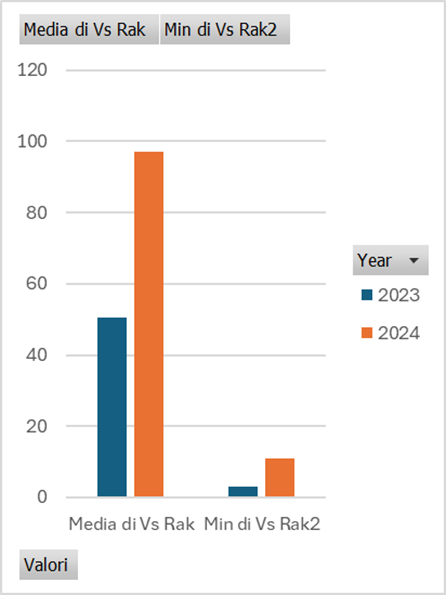
Break Points: One aspect frequently discussed about Sinner in the last 12 months is his overall growth in all areas: technical, physical, and mental. However, it’s not news that Jannik is mentally tough. Surely, Sinner will continue to tirelessly work on this aspect, as he has always stated, but his starting base has always been enviable. And the results are there for everyone to see. Despite facing a number of break points in the tournament equal to 20 in both 2023 and 2024 – which perhaps was unexpected given the more modest caliber of opponents – the Italian’s response was undeniable. An 80% break point save rate, compared to 65% in 2023 and against an ATP tour average of 61%. (Note: The tour average refers to the average of the last 52 weeks of players who have competed in ATP level tournaments). This figure, among other things, underscores Jannik’s solidity, already above average in 2023.

Service – Overall Statistics: Another aspect that has been frequently discussed is Jannik’s improvement in his service game; indeed, the data speaks for itself. Both in terms of the percentage of first serves in play and in terms of effectiveness in converting such a play situation into a point, Sinner has significantly elevated his game. Working on the percentage of first serves in play was the number one priority to improve the Italian’s game performance, and the efforts of Vagnozzi, Cahill & co. have paid off handsomely. In 2023 in Rotterdam, the percentage of first serves in play was 57%, in line with the general performances recorded by Sinner up to that point. Considering that the ATP tour average was 62%, it’s clear this was an aspect still needing improvement until last year. However, the conversion rate from good became excellent. In 2023 in Rotterdam, the conversion rate of points on the first serve stood at 74%, a figure above the tour average, which is at 72%. In 2024, however, we witnessed a further leap forward, reaching the 80% threshold.
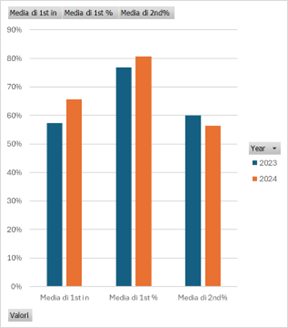
To understand how high this figure is, just look at the leaderboard rankings of the last 52 weeks. In terms of first serves converted into points, 80% is the threshold of absolute excellence. Consider that the two most impressive serving machines ever seen on a tennis court, Karlovic and Isner, had career averages of 83% and 80%, respectively.
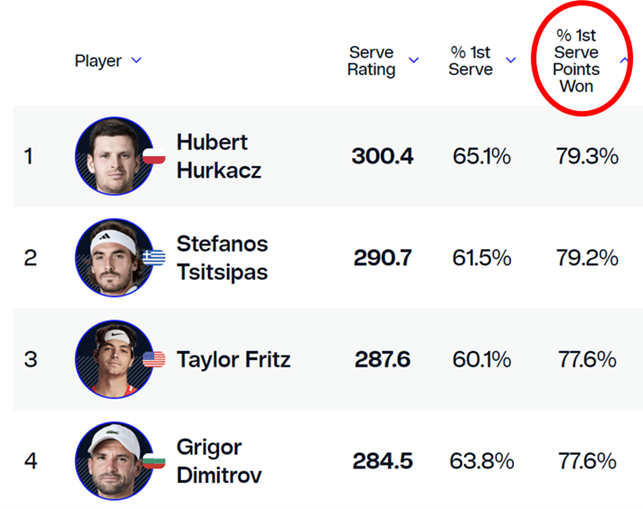
Finally, a somewhat surprising data point is the success performance on the second serve. The Italian won 60% of the points on his second serve in 2023, while in 2024, “only” 56%. This rate is evidently more than sufficient to win matches and tournaments, but in 2023, it was not a problem at all, on the contrary.
Delving further into detail and referring to more detailed analyses (for the metrics used, we also refer to the general description found here), the analysis is further enriched. The data reported are the result of TennisViz processing, on data owned by Tennis Data Innovations (TDI).
Service – Detailed Data: The service performance, in terms of precision and reliability of the shot under pressure, has improved from all perspectives. Among the various metrics available, there are some of interest. Starting with the accuracy on the first serve, i.e., the distance with which the serve is placed from the service lines, measured in cm. Referencing a post from the X Tennis Insights account, we have an overview.
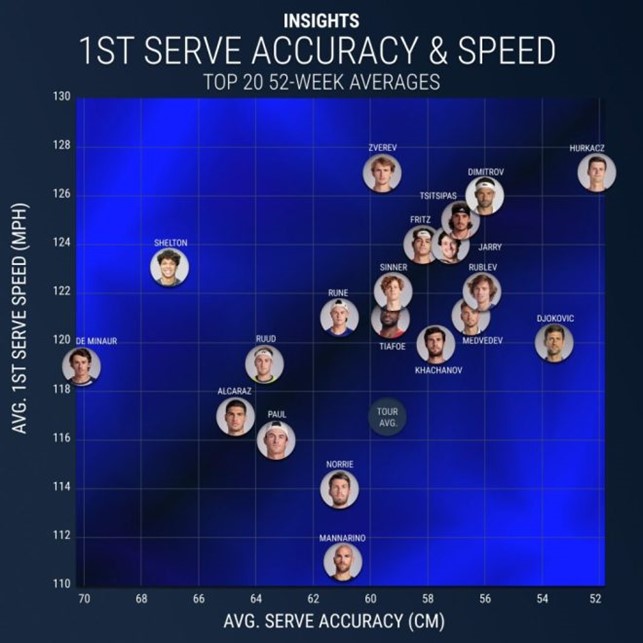
In Rotterdam in 2023, Sinner executed this shot with an accuracy of 57 cm, better than what was measured over the course of the year. But in 2024, this figure impressively dropped to a notable 52 cm, in line with that of Hurkacz. We’ll spare you the statistical details, but the result (highly debatable, given the small sample size) is as follows.
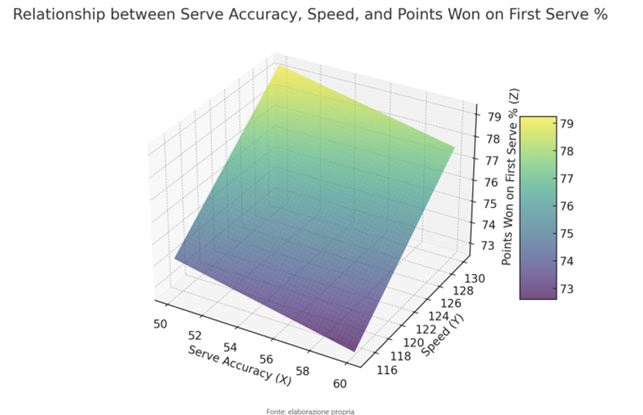

Of course, there are many other variables that explain the yield on the first serve, but the inverse correlation between serve speed and precision is not bad, and generally leads us to say that serving at 125 mph with an accuracy of 52 cm, combined with an average quality in return shots, guarantees an untouchable performance of 80% of points won on the first serve. If the quality is that of Sinner’s serving machine, even less will suffice.
Continuing with the quality of the service shown by Sinner, another data point that deserves further exploration is that of unreturned serves, where the opponent fails to return the serve back into play. Here too, Jannik performed exceptionally well, with aces and opponents’ missed returns bringing home an impressive 40% in 2023 and an exceptional 42% in 2024. Remember, in tennis, variations of 1% can make the difference between a solid top ten player and a Grand Slam title winner. To put it in perspective, the ATP average is 38%.
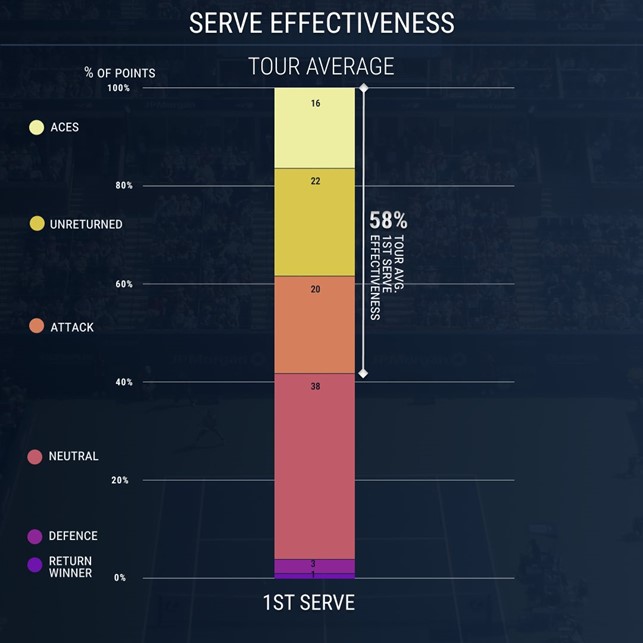
Finally, to conclude the chapter on the serve, one last piece of data, which we’ve kept in reserve for the most deserving who have persisted in reading up to this point; do you know what the percentage of first serve balls on break points was in 2023? And in 2024? Well, we’ll present it to you in a table, and we’ll add nothing more:

In 2023, when serving on break points, the first serve landed much less than usual in crucial moments. In 2024, however, the Italian did not lose his composure at all, serving as if it were any other point… not bad at all.
Performance in rallies: in this case, we rely on [metrics developed by TDI and TennisViz, which obviously carry the ATP brand](https://www.atptour.com/en/news/insights-introduction); (bonus: if you happen to watch a match on ATP TV, these advanced metrics are just a click away, in the stats section of the App).

It’s notable how Jannik has leveled up both in his ability to convert points where he had the advantage (conversion score) and in managing to seize the initiative from opponents when they were in a favorable position during the rally (steal score). Lastly, the final data point: from the baseline, with the current form of Jannik, it’s tough to come out on top, and if we consider his aptitude for turning defense into offense, the puzzle for his opponents is almost unsolvable. Indeed, this explains the overwhelming 56% of points won from the baseline, significantly above the ATP average. This data also finds an explanation in a significant tactical adjustment, the more pronounced use of the down-the-line backhand variation. The backhand crosscourt is already a comfort zone for Sinner, which he can comfortably use to extract points, like a boxer working his opponent with jabs; if we add that now Sinner is also able to find the down-the-line solution at the right moment, again, it spells trouble for his opponents. In 2023, Sinner hit 19.5% of his backhands down the line, while in 2024 this percentage rose to 31.4% in the Rotterdam tournament. A change that helped him tip the scale further in his favor in baseline battles.

Alejandro Tabilo Achieves Italian Open Breakthrough Without Coach

Internazionali d’Italia Daily Preview: Two Blockbuster WTA Semifinals

Aryna Sabalenka Overcomes Injury Doubts To Reach Rome Semi-Finals

‘Increase Security’ The Best Way To Deal With Protest Threat, Says No.1 Iga Swiatek

Daniil Medvedev Targets French Open Breakthrough After Rome Disappointment

Ex-No.2 Paula Badosa Vows To Continue Career Despite Back Injury

Ons Jabeur Explains Partnership With Ex-No.7 Verdasco In Madrid

British BJK Captain Keothavong Criticises Emma Raducanu’s Madrid Open Performance

Martina Navratilova Stands By Criticism Of WTA’s Move To Saudi Arabia

Alexander Zverev Pays Tribute To Retiring Thiem After Rome Win

VIDEO EXCLUSIVE: Danielle Collins Triumphs In Miami As Elena Rybakina Pays The Price For Three Set Marathons

VIDEO EXCLUSIVE: Who Is The Better Player Between Jannik Sinner And Carlos Alcaraz?

(VIDEO) Miami Open Women’s Draw Preview: Is Iga Swiatek Unbeatable?

(VIDEO) Miami Open Men’s Draw Preview: Can Jannik Sinner Bounce Back?

(VIDEO) Carlos Alcaraz Reigns Supreme At Indian Wells, Continues Rivalry With Jannik Sinner
Trending
-

 ATP3 days ago
ATP3 days agoStefanos Tsitsipas Says Expanded Masters Events ‘Playing A Massive Role’ In Player Injuries
-

 Latest news2 days ago
Latest news2 days agoDanil Medvedev battles past Hamad Medjedovic to reach the fourth round in Rome
-

 ATP1 day ago
ATP1 day agoDaniil Medvedev Targets French Open Breakthrough After Rome Disappointment
-

 WTA3 days ago
WTA3 days agoNaomi Osaka Gaining In confidence As Rome Run Comes To An End
-

 Focus2 days ago
Focus2 days agoInternazionali d’Italia Daily Preview: Swiatek, Gauff Play Their Quarterfinals
-

 WTA3 days ago
WTA3 days agoIga Swiatek And Coco Gauff Survive Fourth Round Obstacles In Rome
-

 Focus2 days ago
Focus2 days agoInternazionali d’Italia Daily Preview: Wednesday’s WTA Quarterfinals Feature Three Major Champions
-

 Latest news2 days ago
Latest news2 days agoTaylor Fritz overcomes Grigor Dimitrov to reach the quarter finals in Rome

